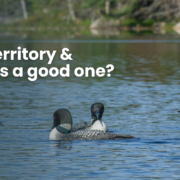Exploring the Wonders of Loon Conservation: Live Loon Cams, Guided Paddles, and Community Engagement
This summer has been off to an amazing start here at the Loon Preservation Committee. I began my role as the Education and Outreach Intern at LPC on May 25th. The following day, I was invited to head out on the water to help set up the stand that would support one of our two Live Loon Cams. We had a tricky task. We needed to get the post set up and leveled while our boat was constantly turning and drifting due to the wind. After quite a bit of work, the post was secure and able to stand on its own. Not long after, Loon Cam 2 was fastened to the post.
A week later, Loon Cam 2 went live. Thanks to the live camera, we have been able to see a pair of loons utilizing the nest raft. These live cameras are truly amazing because they offer the opportunity to obtain an up-close and personal view of the loon nesting process without the need for humans to be out on the water. In fact, because we make sure to keep a respectful distance from loons when we are out on the water, the Live Loon Cams tend to give us a better view than we would be able to get in person. As a result, the Live Loon Cams provide us with a uniquely intimate view of these wonderful birds, as well as other species that we might spot through the cams. Just the other day, we observed several turtles resting on one of the nest rafts!
As fantastic as the Live Loon Cams are for being able to observe loons from anywhere, many of the team members here at LPC also love to get out on the water. On May 27th, I traveled to two lakes in northern New Hampshire for my first guided paddling trips. I was not sure exactly what to expect, but I was prepared for the possibility that we might not see any loons on the water. However, before I even had the chance to put my kayak in the water, we spotted our first loon of the day. Then, while on the water, we located a loon on a nest. We kept our distance and watched for any signs that the loon may have been concerned or stressed due to our presence. We were happy to see that the loon made no calls of distress and maintained a relaxed, upright posture and rounded brow. We spent some time peacefully drifting on the water while observing the loon and while discussing loons and the work of LPC. Then we moved on to our second lake of the day. There, we spotted a pair of loons on the water. I looked behind us a couple of times as we continued our paddle around the lake and found that the loons appeared to be following us on our paddle. These guided paddles were a great way to enjoy these lakes and see loons on the water. I am excited to have the opportunity to lead guided paddles in the coming weeks. If you are interested in attending one, please view our events calendar!
The Loon Center here in Moultonborough has also been a hub of activity these past few weeks. Between preparing signs for loon nesting sites, carrying out loon necropsies, working on the Lead Tackle Buyback initiative, and delivering lectures on loons, there has been a lot of really great work going on! I have had the pleasure of giving my first few presentations on loons here at the center and elsewhere around the state. We are always extremely thankful and appreciative of those who host us for these presentations and those who come to listen and chat with us. It has been an absolute joy to speak with people who express a common interest in loons. I look forward to continuing to meet more of you, whether it is through the chat feature of our Live Loon Cam or in person at the Loon Center, other sites around the state, or on the water.



